Zic2 hypomorphic mutant mice as a schizophrenia model and ZIC2 mutations identified in schizophrenia patients
- PMID: 22355535
- PMCID: PMC3216504
- DOI: 10.1038/srep00016
Zic2 hypomorphic mutant mice as a schizophrenia model and ZIC2 mutations identified in schizophrenia patients
Erratum in
- Sci Rep.2011;1:49
Abstract
ZIC2 is a causal gene for holoprosencephaly and encodes a zinc-finger-type transcriptional regulator. We characterized Zic2(kd/+) mice with a moderate (40%) reduction in Zic2 expression. Zic2(kd/+) mice showed increased locomotor activity in novel environments, cognitive and sensorimotor gating dysfunctions, and social behavioral abnormalities. Zic2(kd/+) brain involved enlargement of the lateral ventricle, thinning of the cerebral cortex and corpus callosum, and decreased number of cholinergic neurons in the basal forebrain. Because these features are reminiscent of schizophrenia, we examined ZIC2 variant-carrying allele frequencies in schizophrenia patients and in controls in the Japanese population. Among three novel missense mutations in ZIC2, R409P was only found in schizophrenia patients, and was located in a strongly conserved position of the zinc finger domain. Mouse Zic2 with the corresponding mutation showed lowered transcription-activating capacity and had impaired target DNA-binding and co-factor-binding capacities. These results warrant further study of ZIC2 in the pathogenesis of schizophrenia.
Figures
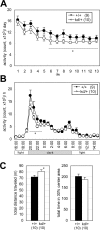
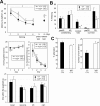
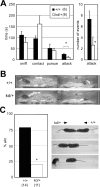
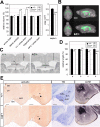
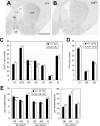
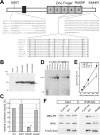
Similar articles
-
Behavioral abnormalities of Zic1 and Zic2 mutant mice: implications as models for human neurological disorders.Behav Genet. 2001 May;31(3):317-24. doi: 10.1023/a:1012235510600. Behav Genet. 2001. PMID: 11699604
-
Mutations in ZIC2 in human holoprosencephaly: description of a novel ZIC2 specific phenotype and comprehensive analysis of 157 individuals.J Med Genet. 2010 Aug;47(8):513-24. doi: 10.1136/jmg.2009.073049. Epub 2009 Dec 2. J Med Genet. 2010. PMID: 19955556 Free PMC article.
-
In vitro analysis of partial loss-of-function ZIC2 mutations in holoprosencephaly: alanine tract expansion modulates DNA binding and transactivation.Hum Mol Genet. 2005 Feb 1;14(3):411-20. doi: 10.1093/hmg/ddi037. Epub 2004 Dec 8. Hum Mol Genet. 2005. PMID: 15590697
-
ZIC2 in Holoprosencephaly.Adv Exp Med Biol. 2018;1046:269-299. doi: 10.1007/978-981-10-7311-3_14. Adv Exp Med Biol. 2018. PMID: 29442327 Review.
-
Rare nasal cleft in a patient with holoprosencephaly due to a mutation in the ZIC2 gene.Birth Defects Res A Clin Mol Teratol. 2014 Apr;100(4):300-6. doi: 10.1002/bdra.23216. Epub 2014 Feb 12. Birth Defects Res A Clin Mol Teratol. 2014. PMID: 24677696 Review.
Cited by
-
Zebrafish zic2 controls formation of periocular neural crest and choroid fissure morphogenesis.Dev Biol. 2017 Sep 1;429(1):92-104. doi: 10.1016/j.ydbio.2017.07.003. Epub 2017 Jul 6. Dev Biol. 2017. PMID: 28689736 Free PMC article.
-
Identification and Analysis of ZIC-Related Genes in Cerebellum of Autism Spectrum Disorders.Neuropsychiatr Dis Treat. 2024 Feb 22;20:325-339. doi: 10.2147/NDT.S444138. eCollection 2024. Neuropsychiatr Dis Treat. 2024. PMID: 38410689 Free PMC article.
-
The transcription factor odd-paired regulates temporal identity in transit-amplifying neural progenitors via an incoherent feed-forward loop.Elife. 2019 Jul 22;8:e46566. doi: 10.7554/eLife.46566. Elife. 2019. PMID: 31329099 Free PMC article.
-
Joint multi-ancestry and admixed GWAS reveals the complex genetics behind human cranial vault shape.Nat Commun. 2023 Nov 16;14(1):7436. doi: 10.1038/s41467-023-43237-8. Nat Commun. 2023. PMID: 37973980 Free PMC article. Review.
-
Link between the causative genes of holoprosencephaly: Zic2 directly regulates Tgif1 expression.Sci Rep. 2018 Feb 1;8(1):2140. doi: 10.1038/s41598-018-20242-2. Sci Rep. 2018. PMID: 29391420 Free PMC article.
References
-
- Aruga J. et al. The mouse zic gene family. Homologues of the Drosophila pair-rule gene odd-paired.J Biol Chem 271, 1043–1047 (1996). - PubMed
-
- Nagai T. et al. The expression of the mouse Zic1, Zic2, and Zic3 gene suggests an essential role for Zic genes in body pattern formation. Dev Biol 182, 299–313 (1997). - PubMed
-
- Aruga J. The role of Zic genes in neural development. Mol Cell Neurosci 26, 205–221 (2004). - PubMed
-
- Grinberg I. & Millen K. J. The ZIC gene family in development and disease. Clin Genet 67, 290–296, 10.1111/j.1399-0004.2005.00418.x (2005). - PubMed
-
- Merzdorf C. S. Emerging roles for zic genes in early development. Dev Dyn 236, 922–940 (2007). - PubMed
Publication types
MeSH terms
Substances
LinkOut - more resources
Full Text Sources
Medical
Molecular Biology Databases

